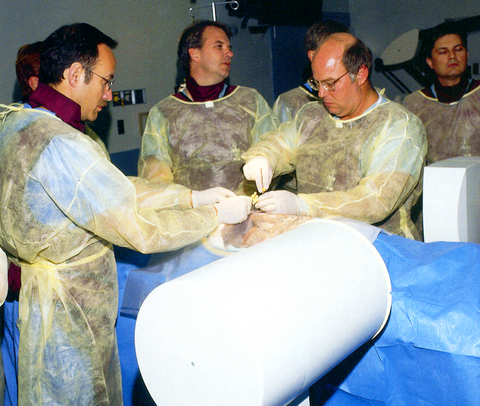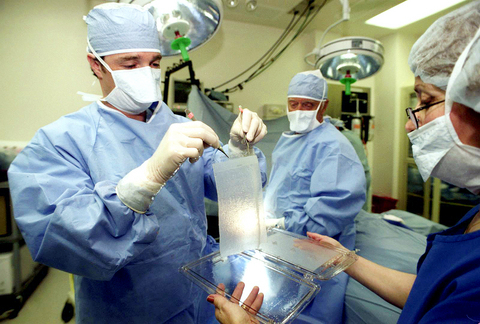At 5 o'clock one morning in late March, Linda Dixon stood in the stream of an open fire hydrant as emergency medical workers flushed her chest, arms and face with water.
Dixon, a 42-year-old home health aide in Queens, New York, said her estranged boyfriend, the father of her three children, had gone into her bedroom and thrown acid on her after a confrontation.
Dixon was taken to the NewYork-Presbyterian/Weill Cornell hospital, where she underwent two surgeries for the worst of her injuries, a third-degree burn across her chest. The surgical team's first priorities were to remove as much of the burned skin as possible (it can easily become infected) and to cover the wound temporarily with skin from a cadaver.

Cadaver skin is removed from donors shortly after their deaths, then processed and distributed by skin and tissue banks. It has long been the preferred option for a patient with the most severe burns until a graft of the patient's own skin can be applied. Although some synthetic skin has come on the market in the last 20 years, new products have not appeared as quickly as some experts expected.
And experts now realize that cadaver skin is unlikely to be replaced as a treatment option anytime soon.
"Cadaver skin still is probably the No. 1 substitute for the patient's own skin" in acute cases, said Roger Yurt, professor of surgery and director of the Hearst Burn Center. Yurt also oversees the hospital's dedicated skin bank, called the New York Firefighters Skin Bank.

Palmer Bessey, professor of surgery and associate director of the burn center, said cadaver skin was particularly valuable in cases like Dixon's, when the burn may penetrate deeper than is immediately apparent. Initially, it may not be clear whether the bed of the wound will be able to accept a graft, and under such circumstances, synthetics are more prone to infection than cadaver skin, Bessey said.
In Dixon's case, Bessey decided to use strips of cadaver skin, which had been frozen at the hospital's skin bank. In the operating room, these strips were thawed in a small tub of saline.
They were rolled through a meshing machine, which created a pattern of small holes, like the pattern in fishnet stockings. This allowed the cadaver skin to be stretched to cover a broader area of Dixon's chest. It also allowed for better drainage of the wound because blood clots or fluid could seep through the perforations and not get stuck under the graft.
Donated skin can help prevent infection, reduce pain and maintain body temperature. Patients with severe burns do not initially reject cadaver skin, because their immune systems are suppressed, Bessey said.
Each strip is about 0.33mm thick, roughly the thickness of sunburned skin. The strip includes the dull outer layer, or epidermis, and a small portion of the shiny inner layer, or dermis. Both are destroyed in a third-degree or full-thickness burn.
When a skin bank receives a call about a potential donor, an extensive screening process begins -- for risk factors associated with HIV, hepatitis, cancer, mad cow disease and even Chagas' disease, a parasitic infection.
"A large proportion of potential donors are rejected," said Nancy Gallo, the administrative director of the Firefighters Skin Bank and a registered nurse.
When donors are accepted and their families consent, a team from the skin bank goes to the hospital and surgically removes roughly 122 square centimeters of a cadaver's skin. The skin is taken to the skin bank, trimmed into bandage-like strips and cryogenically preserved. Cadaver skin can be stored in a freezer for up to five years, although it is invariably needed sooner.
"We are always in need of more skin," Gallo said, adding that the skin bank faces a declining number of donors. "Right now there is a national shortage."
She added that she frequently received calls from people planning to undergo gastric bypass surgery, a surgical treatment for obesity, who would like to donate skin. But given current skin harvesting procedures, this is not an option.
According to Bessey, Dixon responded well to the graft of donated skin, which integrated into her body and helped the area begin healing. Bessey then performed a second operation, removing the cadaver material and replacing it with Dixon's own skin, taken from her thigh.
"I was very scared," Dixon said. But she added that she was in less pain then than she was before the operations.
Most of the less severe burns on Dixon's face are healing naturally. The burn on her right eyelid was too deep to heal by itself, and a graft of her own skin was applied during the second operation, Bessey said.
Richard Kagan, professor of surgery at the University of Cincinnati College of Medicine and chief of staff at the Shriners Burns Hospital in Cincinnati, said that for temporary wound coverage for acute burns, cadaver skin has been the best option for more than 40 years.
"The development of a permanent, off-the-shelf skin replacement has been much slower than had been anticipated," he said, although, he added, "some of the synthetics do have advantages."
Integra artificial skin products, from Integra LifeSciences, are among the most widely used synthetics. Its first skin product received approval from the Food and Drug Administration in 1996 and consisted of two layers: an inner scaffold on which the dermis could redevelop and an outer layer of silicone.
Other skin products, approved in 2002, made small improvements but were not substantially different, according to a company spokeswoman.
Integra's artificial skin products have advantages over cadaver skin in that they are easier to store. Because they help to rebuild the inner, structural layer of skin, they can improve the appearance of a scar. They can also reduce the amount of scarring that contracts around a joint or other areas that requires mobility.
But these products cost more than cadaver skin, Kagan and others say. The products can also be hard to handle and may be more prone to infection, particularly when placed on a wound of questionable viability. And, like patients given cadaver skin, those given artificial skin products must eventually receive grafts of their own skin.
A product called Epicel, introduced by Genzyme Biosurgery in the 1980s, offers a permanent replacement for a patient's outer skin. It consists of a sheet of epidermis, grown and cultured over several weeks from a sample of a patient's own skin cells.
Along similar lines, Steven Boyce, professor of surgery at the University of Cincinnati and a senior researcher at the Shriners Burns Hospital, has developed a laboratory process in which both epidermis and some dermis can be produced in about a month using cells isolated from a patient's skin and grown in culture.
This product, PermaDerm, is being developed by the Cambrex Corp. It is not available now on a large scale. But even it is not a skin replacement that can be used immediately for any permanent wound closure. And for many researchers, such a product remains the dream.

On April 26, The Lancet published a letter from two doctors at Taichung-based China Medical University Hospital (CMUH) warning that “Taiwan’s Health Care System is on the Brink of Collapse.” The authors said that “Years of policy inaction and mismanagement of resources have led to the National Health Insurance system operating under unsustainable conditions.” The pushback was immediate. Errors in the paper were quickly identified and publicized, to discredit the authors (the hospital apologized). CNA reported that CMUH said the letter described Taiwan in 2021 as having 62 nurses per 10,000 people, when the correct number was 78 nurses per 10,000

As we live longer, our risk of cognitive impairment is increasing. How can we delay the onset of symptoms? Do we have to give up every indulgence or can small changes make a difference? We asked neurologists for tips on how to keep our brains healthy for life. TAKE CARE OF YOUR HEALTH “All of the sensible things that apply to bodily health apply to brain health,” says Suzanne O’Sullivan, a consultant in neurology at the National Hospital for Neurology and Neurosurgery in London, and the author of The Age of Diagnosis. “When you’re 20, you can get away with absolute

May 5 to May 11 What started out as friction between Taiwanese students at Taichung First High School and a Japanese head cook escalated dramatically over the first two weeks of May 1927. It began on April 30 when the cook’s wife knew that lotus starch used in that night’s dinner had rat feces in it, but failed to inform staff until the meal was already prepared. The students believed that her silence was intentional, and filed a complaint. The school’s Japanese administrators sided with the cook’s family, dismissing the students as troublemakers and clamping down on their freedoms — with

As Donald Trump’s executive order in March led to the shuttering of Voice of America (VOA) — the global broadcaster whose roots date back to the fight against Nazi propaganda — he quickly attracted support from figures not used to aligning themselves with any US administration. Trump had ordered the US Agency for Global Media, the federal agency that funds VOA and other groups promoting independent journalism overseas, to be “eliminated to the maximum extent consistent with applicable law.” The decision suddenly halted programming in 49 languages to more than 425 million people. In Moscow, Margarita Simonyan, the hardline editor-in-chief of the